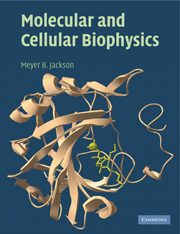Book contents
- Frontmatter
- Contents
- Preface
- Acknowledgements
- Chapter 1 Global transitions in proteins
- Chapter 2 Molecular forces in biological structures
- Chapter 3 Conformations of macromolecules
- Chapter 4 Molecular associations
- Chapter 5 Allosteric interactions
- Chapter 6 Diffusion and Brownian motion
- Chapter 7 Fundamental rate processes
- Chapter 8 Association kinetics
- Chapter 9 Multi-state kinetics
- Chapter 10 Enzyme catalysis
- Chapter 11 Ions and counterions
- Chapter 12 Fluctuations
- Chapter 13 Ion permeation and membrane potential
- Chapter 14 Ion permeation and channel structure
- Chapter 15 Cable theory
- Chapter 16 Action potentials
- Appendix 1 Expansions and series
- Appendix 2 Matrix algebra
- Appendix 3 Fourier analysis
- Appendix 4 Gaussian integrals
- Appendix 5 Hyperbolic functions
- Appendix 6 Polar and spherical coordinates
- References
- Index
Chapter 13 - Ion permeation and membrane potential
Published online by Cambridge University Press: 24 May 2010
- Frontmatter
- Contents
- Preface
- Acknowledgements
- Chapter 1 Global transitions in proteins
- Chapter 2 Molecular forces in biological structures
- Chapter 3 Conformations of macromolecules
- Chapter 4 Molecular associations
- Chapter 5 Allosteric interactions
- Chapter 6 Diffusion and Brownian motion
- Chapter 7 Fundamental rate processes
- Chapter 8 Association kinetics
- Chapter 9 Multi-state kinetics
- Chapter 10 Enzyme catalysis
- Chapter 11 Ions and counterions
- Chapter 12 Fluctuations
- Chapter 13 Ion permeation and membrane potential
- Chapter 14 Ion permeation and channel structure
- Chapter 15 Cable theory
- Chapter 16 Action potentials
- Appendix 1 Expansions and series
- Appendix 2 Matrix algebra
- Appendix 3 Fourier analysis
- Appendix 4 Gaussian integrals
- Appendix 5 Hyperbolic functions
- Appendix 6 Polar and spherical coordinates
- References
- Index
Summary
A cell expends metabolic energy to transport ions, accumulating some and expelling others so that the concentrations differ between the cell's inside and outside. The cell membrane is more permeable to some of these ions than to others, so ions will move passively down their concentration gradients at different rates. The resulting separation of charge generates a voltage difference. Essentially every cell has a membrane potential arising from ion movement. The movement of different ions across the cell membrane produces a broad spectrum of electrical behavior and makes it possible for cells to communicate by electrical signaling. Electrical potentials also appear across the membranes of organelles, and across layers of cells such as epithelia. The common theme with all these phenomena is the selective permeability of a membrane to different ions. Here we will examine the relation between membrane permeability, ion flux, and membrane potential. We will not worry about the precise mechanism of ion permeation here. That is a subject for the next chapter.
Nernst potentials
Consider two compartments separated by a membrane, with a higher concentration of salt on one side than on the other (Fig. 13.1). If only one ion is permeant, then that ion will diffuse across the membrane down its concentration gradient, but the other ions will remain behind. This produces a charge imbalance and therefore a membrane potential.
- Type
- Chapter
- Information
- Molecular and Cellular Biophysics , pp. 339 - 366Publisher: Cambridge University PressPrint publication year: 2006



